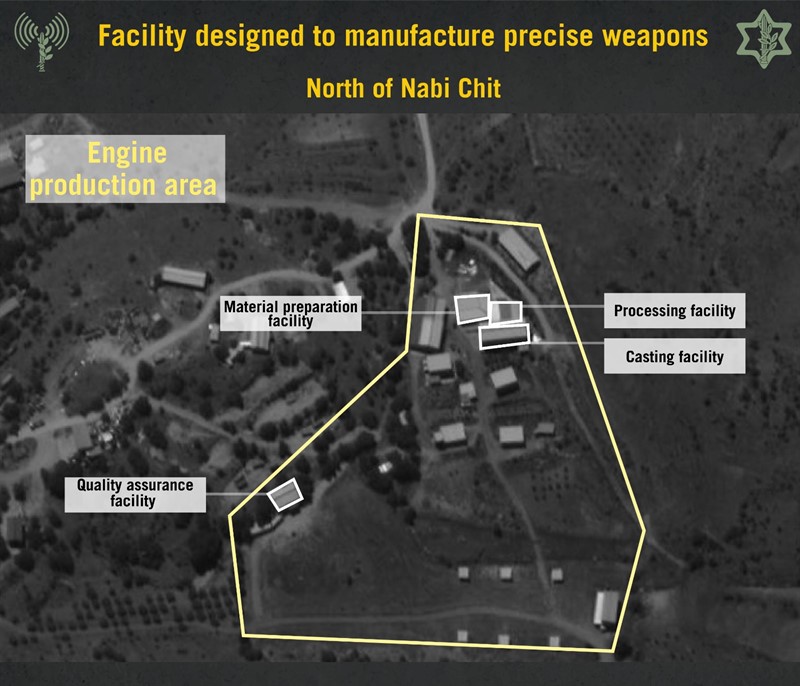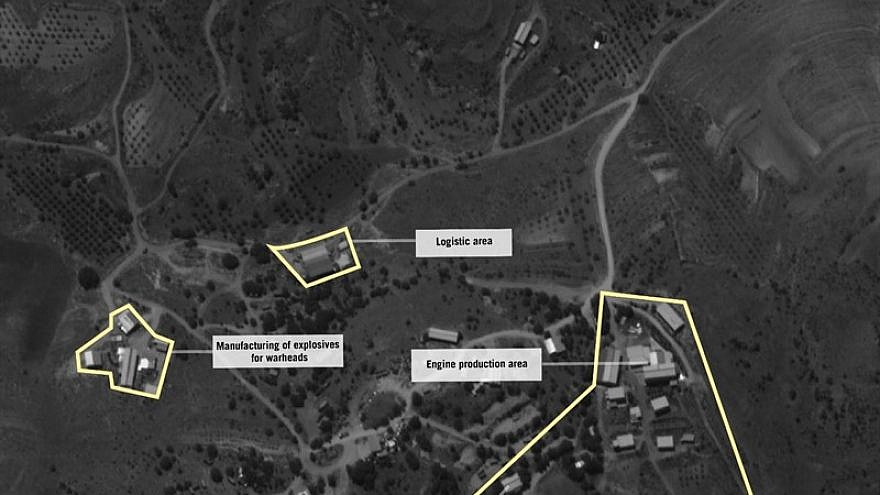Days after a major security escalation erupted between Hezbollah and Israel, and amid Israeli warnings over Hezbollah’s precision-missile program, the Israel Defense Forces exposed on Tuesday a new facility in eastern Lebanon for the production of guided missiles.
The site, located near Nabi Chit in the Bekaa Valley, is designed to “convert and manufacture precision guided missiles,” and “was established a few years ago by Iran and Hezbollah in order to manufacture weapons,” the IDF stated. Aerial photos of the facility, showing structures to create explosive warheads, engines and a “quality assurance” center were released by the IDF.
Arabic-language media outlets said Israel conducted an airstrike in the same area on Aug. 26. The alleged target of the strike was not confirmed, though reports at the time claimed that a base belonging to a Palestinian armed faction was hit.
On Tuesday, the IDF stated, “Lately, various activities to facilitate the manufacture and conversion of precision guided missiles at the facility have been identified, including the establishment of a dedicated assembly line for precision weapons, and the transfer of sensitive and dedicated equipment. The facility holds a number of machines designed to manufacture the motors and the warheads of missiles with an accuracy of less than 10 meters. In order to manufacture the missiles, Iran supplies special machines and instructs the manufacturing crews, in addition to continuous supporting guidance.”

According to the military, the facility plays a critical role in Hezbollah’s guided-missile program, adding that “Hezbollah, in fear of strikes, evacuated precious and unique equipment from the compound to civilian locations in Beirut.”
The exposure of the latest site comes at the same time as a dramatic uptick in tensions surrounding Hezbollah’s precision-missile program, which Iran is helping the terror organization construct in Lebanon.
On Aug. 25, according to international media reports, Israeli drones destroyed a key component hidden in southern Beirut for producing high-grade propellant for guided ballistic missiles. That same evening, Israel Air Force jets bombed an Iranian-led squad that was preparing to launch explosive drones from Syria into Israel. Two Hezbollah members of the squad were killed.
In retribution, Hezbollah fired anti-tank guided missiles at an IDF base and a military vehicle on Sept. 1. Israel responded by launching some 100 artillery shells and directing helicopter fire at Hezbollah.
‘A real possibility of serious deterioration’
Ultimately, according to Ely Karmon, a senior research scholar at the International Institute for Counter-Terrorism (ICT) in Herzliya, the Jewish state has changed its strategy concerning Hezbollah’s dangerous force build-up. “This should have been stopped a long time ago,” Karmon told JNS, noting that Hezbollah has been aggressively building up its offensive firepower since before the 2006 Second Lebanon War and in earnest after it.
Iran has flooded Lebanon with rockets, leading to a massive Hezbollah armament drive. Although the vast majority of Hezbollah’s arsenal is still unguided, even those types of projectiles pose a severe risk to Israeli civilians, noted Karmon.
“While the issue of precision missiles is of top importance, the fact that some 150,000 inaccurate projectiles are also pointed at Israel has been swept under the carpet,” he said. “We’ve heard IDF assessments that Hezbollah can fire 1,500 to 2,000 rockets per day. What does this mean for civilians? We’ve heard the Home Front Command and heads of local northern councils say they are not ready.”
Karmon welcomed Israel’s campaign against the sophisticated guided-missile threat developing in Lebanon, adding that this type of active threat prevention was long overdue.
“The question is whether we have to be careful because of [Hezbollah leader Hassan] Nasrallah’s threats,” he said. “There is a real possibility of a very serious deterioration. My assessment is that Israel must not let Nasrallah go back to the same force build-up as before. Not just in terms of the precision missiles, but in general.”
Hezbollah’s arsenal of unguided projectiles can cause “hundreds of civilian deaths, if not more” in the event of a full-scale war, warned Karmon. Such large-scale rocket fire would flood Israeli air defenses, meaning that the Jewish state must be “very firm not just against the build-up of precise missiles, but against all projectiles.”
Karmon praised the latest Israeli military steps to limit the developing missile threat in Lebanon, but criticized what he described as politically motivated boasts regarding such action, made by government officials. He said that there has been a reduction of previous Israeli vagueness regarding the low-profile campaign against threats in the region.
“The fact that the policy of vagueness is being reduced is something that is opposed by most former defense officials. This is all linked to elections,” said Karmon. “The military operations are strategically vital. But politically, discussing them does not serve security.”
Meanwhile, Iran—Hezbollah’s sponsor—is exploring the possibility entering into a new diplomatic process with Washington and the European Union, with France as an intermediary. That could rescue Tehran’s economy from biting American sanctions.
As a result, Iran is activating its Shi’ite terror proxy in Lebanon, but is not seeking full-scale war in order to avoid upsetting the possibility for sanctions relief, argued Karmon. This creates a sphere for Israel to operate in and deal with Hezbollah’s weapons program wherever necessary.
“We are late to this by years,” said Karmon. “In the past few years, Israel decided that it can’t allow these weapons to take root in Syria. Israel must also deal with the offensive infrastructure in Lebanon.”


























